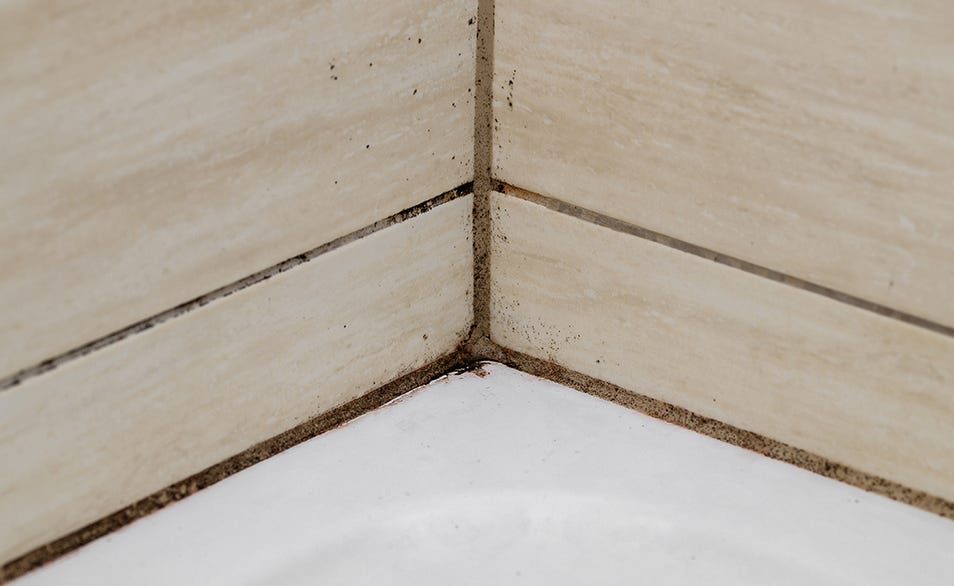How to Remove Black Mould from Silicone Sealant | Cillit Bang

How to remove black mould from silicone sealant
Are you tired of dealing with stubborn black mould in your bathroom or kitchen? We understand how frustrating and unsightly this problem can be. That's why we're here to provide you with practical tips on how to remove black mould from silicone sealants and restore your home’s cleanliness.
Why mould is making your silicone turn black
When your silicone is wet or damp and there are soap deposits, this encourages mould growth, which in turn causes your silicone to turn black. This can happen in a number of places around the home, including the areas around your bath, shower, windows, doors and so on. The good news is this is preventable. So, let’s find out how can we tackle this problem head on!
Step 1: Get the essentials
First, you'll need a few items on hand before you start cleaning. Grab a pair of rubber gloves, a sponge or brush to scrub away the mould and a mildew remover or bleach to effectively clean and disinfect the affected areas. Finally, have a clean cloth ready to wipe away any residue. With these materials in hand, you'll be well-prepared to tackle the black mould and restore the cleanliness of your silicone sealant.
Step 2: Preparing the area
Start by ensuring good ventilation in the room by opening windows or using a fan—this will help prevent the spread of mould spores and provide fresh air during the cleaning process. Next, remove any dirt from the silicone sealant using a dry cloth or brush. This will allow the solution to penetrate the mould more effectively.
Step 3: Applying the solution
Once you’ve cleaned the affected area, it's time to apply the cleaning solution to the black mould on the silicone sealant. There are a couple of options you can choose from. You can either use a mildew remover like Cillit Bang Mould Remover, specifically designed for this purpose or create a natural cleaning solution using one part bleach and four parts water. If you’re using the Cillit Bang Mould Remover, keep the trigger straight 20cm from the surface, then
Step 4: Scrubbing away the mould
Use a sponge or scrub brush and gently scrub the affected areas. Apply gentle pressure to ensure effective mould removal, paying extra attention to any stubborn areas or deep crevices where mould may be hiding. It's important to rinse the sponge or brush frequently to prevent spreading the mould to other areas. Cillit Bang Expert Black Mould Remover is even effective without scrubbing.
Step 5: Let the solution sit
Once you have scrubbed away the mould, it's important to let the cleaning solution sit on the silicone sealant for a few minutes. If using the Cillit Bang Mould Remover, let it sit for 5 minutes to kill 99.9% of bacteria and viruses or 15 minutes to eliminate
Step 6: Rinsing the area
With clean water and a cloth or sponge, rinse the surface multiple times to ensure all traces of the cleaning solution and mould are removed. Without doing this, you might not be able to get rid of the black mould effectively. Your silicone sealant should be glistening and ready for the final step in the cleaning process.
Step 7: Dry it off
Grab the cloth you gathered earlier and use it to remove any excess moisture from the silicone sealant—an area that’s consistently damp is one of the main causes of black mould. If you’re eager for the area to dry, use a fan or open windows. You’ve taken a vital step in clearing any remaining moisture and discouraging the growth of black mould.
Step 8: Prevention is key
To win the war, not just the battle against black mould, ventilation is key in areas prone to moisture, such as bathrooms, windowsills and kitchens. If you want to remove black mould from silicone sealant around windows, open your windows to ensure good airflow or consider getting an exhaust fan. Regularly clean and dry the silicone sealant, removing any moisture or debris that may encourage mould growth. Additionally, consider using a mould-resistant silicone sealant for a longer-term solution.
Now you have all the necessary tools to prevent black mould from contaminating your silicone sealant and can finally enjoy a mould-free home.
